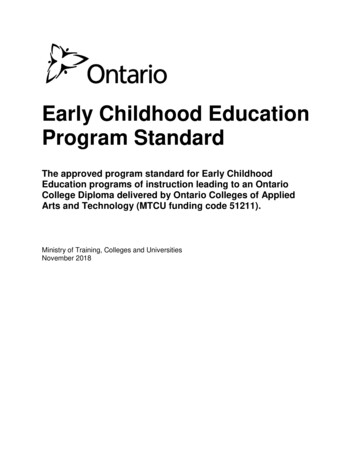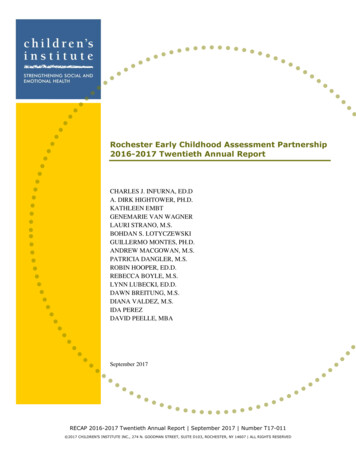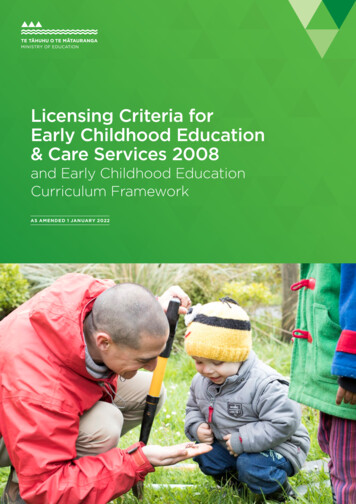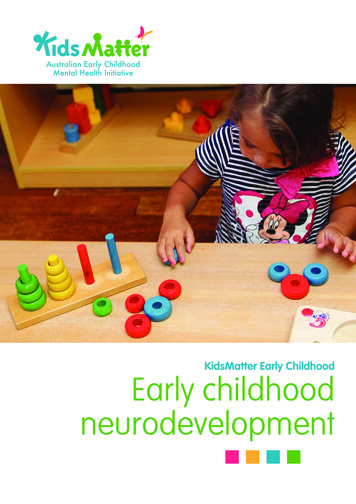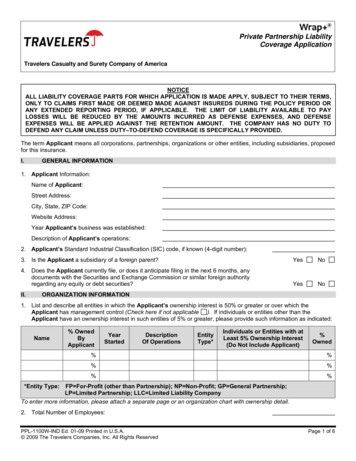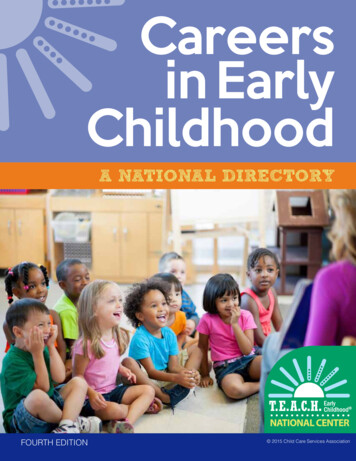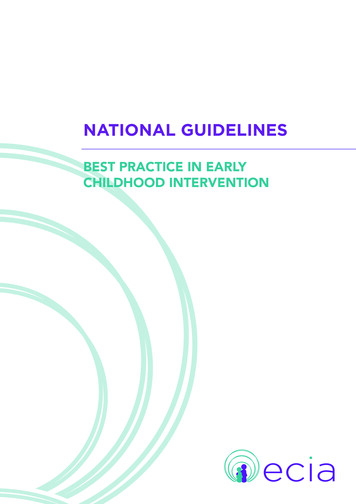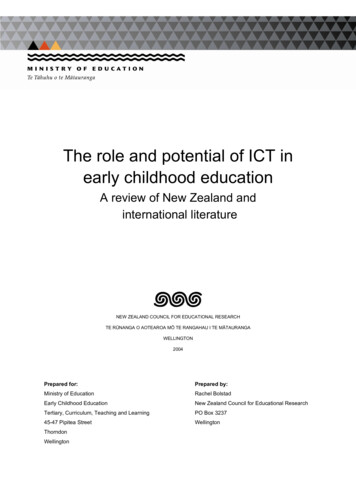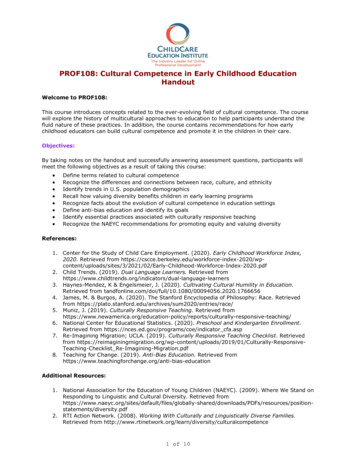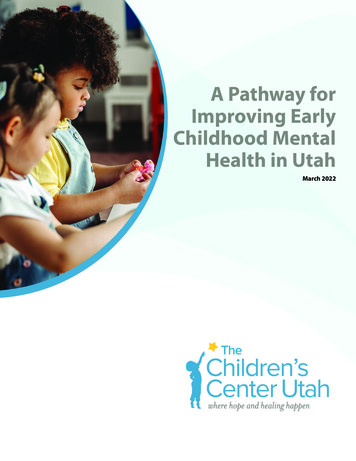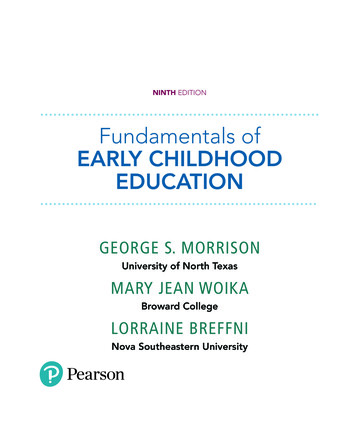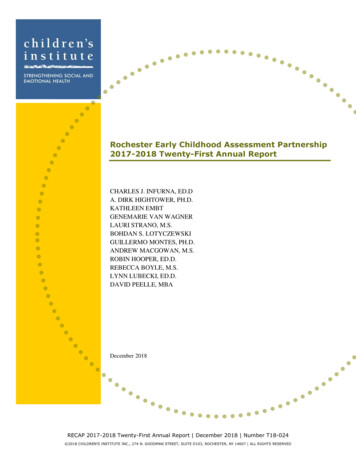
Transcription
Rochester Early Childhood Assessment Partnership2017-2018 Twenty-First Annual ReportCHARLES J. INFURNA, ED.DA. DIRK HIGHTOWER, PH.D.KATHLEEN EMBTGENEMARIE VAN WAGNERLAURI STRANO, M.S.BOHDAN S. LOTYCZEWSKIGUILLERMO MONTES, PH.D.ANDREW MACGOWAN, M.S.ROBIN HOOPER, ED.D.REBECCA BOYLE, M.S.LYNN LUBECKI, ED.D.DAVID PEELLE, MBADecember 2018RECAP 2017-2018 Twenty-First Annual Report December 2018 Number T18-024 2018 CHILDREN’S INSTITUTE INC., 274 N. GOODMAN STREET, SUITE D103, ROCHESTER, NY 14607 ALL RIGHTS RESERVED
Rochester Early Childhood Assessment Partnership2017-2018 Twenty-First Annual ReportCHARLES J. INFURNA, ED.DA. DIRK HIGHTOWER, PH.D.KATHLEEN EMBTGENEMARIE VAN WAGNERLAURI STRANO, M.S.BOHDAN S. LOTYCZEWSKIGUILLERMO MONTES, PH.D.ANDREW MACGOWAN, M.S.ROBIN HOOPER, ED.D.REBECCA BOYLE, M.S.LYNN LUBECKI, ED.D.DAVID PEELLE, MBADecember 2018Children’s Institute is a recognized leader in programs, research, and evaluations supporting children’s socialand emotional health. Our partner COMET Informatics offers a data support system that provides informeddecision-making, organizational quality improvements, and improved outcomes for children and youth.Children’s Institute (EIN 23-7102632) is a 501 (3) non-profit organization.For more information, visit www.childrensinstitute.net and www.comet4children.comRECAP 2017-2018 Twenty-First Annual Report December 2018 Number T18-024 2018 CHILDREN’S INSTITUTE INC., 274 N. GOODMAN STREET, SUITE D103, ROCHESTER, NY 14607 ALL RIGHTS RESERVED
Table of ContentsAcknowledgmentsiExecutive SummaryiiIntroduction to RECAP1Program Quality – ECERS-35Program Quality – CLASS9Student Performance – AcademicsBriganceChild Observation Record-Advantage (COR )UPK Special EducationDose of ProgrammingTeacher-Child Rating Scale (T-CRS)Student Outcomes and Attendance18182126293135Family Perspectives46Recommendations67Presentations and Publications71References72RECAP 2017-2018 Twenty-First Annual Report December 2018 Number T18-024 2018 CHILDREN’S INSTITUTE INC., 274 N. GOODMAN STREET, SUITE D103, ROCHESTER, NY 14607 ALL RIGHTS RESERVED
iAcknowledgmentsThis report was made possible by the contributions of many partners, including early educationprograms, funders, parents, volunteers, and other interested groups. We thank the manyindividuals who, year after year, give their time, ideas and support to RECAP (formally knownas the Rochester Early Childhood Assessment Partnership).Financial support was provided by the Rochester Area Community Foundation, Rochester'sChild Fund of the Rochester Area Community Foundation, Rochester City School District, andNew York State Education Department.Program partners include: Action for a Better Community’s Early Education Division, EarlyChildhood Education Quality Council Centers, including: Asbury Day Care Center, Baden StreetCenters, Community Child Care Center, Creative Beginnings Lakeside Early Learning Center,Friendship Children’s Center, Ibero Early Childhood Services, Oregon Leopold Day CareCenter, Richard M. Guon Child Care Center at Monroe Community College, RochesterChildfirst Network, St. Paul’s Child Care Center, and Volunteers of America Children’s Center,Florence S. Brown Pre-K School, Rochester City School District Montessori Academy,Rochester City School District Rochester Early Childhood Education Center, RochesterPreschool-Parent Program, all other Rochester City School District programs, YMCA programs,and the following independent child care centers: Caring and Sharing Child Care Center, TheCommunity Place of Greater Rochester, Family Resource Centers, Generations Child CareCenters, Little Hearts Child Care, and Sunshine Village Child Care Centers.We thank the teachers, adult family educators, parent coordinators, directors, and administratorswho work closely with thousands of students and their parents. Their personal attention tofamilies contributes greatly to RECAP. These individuals contribute valuable information andshare their insight with the RECAP Assessment Team, which is vital to our continuousimprovement system. We would especially like to recognize and thank the teachers who havecontinued to help us improve the process of collecting and sharing information about the childrenin RECAP. Their comments and feedback, especially regarding new software and data collectionand management technology, have been invaluable.We thank the thousands of parents who gave time from their busy schedules to share theirthoughts and perceptions about their children and other topics. Without parents, RECAP wouldnot be as complete or comprehensive.We thank the RECAP Advisory Council and especially Nancy Kaplan, its chair, for helping us tokeep the needs of children and all our partners foremost in our operations, and for its valuablefeedback and insights regarding the current goals and activities of our community’s earlychildhood system.We thank the communications staff of Children’s Institute for contributions to this report.RECAP 2017-18 Twenty-First Annual Report December 2018 Number T18-024 2018 CHILDREN’S INSTITUTE INC., 274 N. GOODMAN STREET, SUITE D103, ROCHESTER, NY 14607 ALL RIGHTS RESERVED
iiExecutive SummaryRECAP’s Major Findings for 2017-2018 – Expanded Prekindergarten(EPK; for 3-year-olds)Students As measured by the Brigance Early Childhood Screen (Brigance), 75% of incomingthree-year olds were functioning in normal and possibly talented range. This finding issimilar to that of the 2016-17 school year, in which 73% of incoming three-year oldswere within the same range (Infurna et al., 2017) Similar to their UPK peers, EPK students made significant gains in all the ChildObservation Record Advantage (COR) domains, especially on the COR Overall (effectsize, d 2.0) Socially and emotionally, we found similar outcomes in EPK as we did with UniversalPrekindergarten (UPK) students. The Assertiveness domain of the T-CRS showed thelargest gain (d .25), with negligible gains in Task Orientation, Behavior Control, andPeer Social SkillsClassrooms Overall, 76 EPK teachers were observed with the Early Childhood Environment RatingScale – Third edition (ECERS-3). The overall ECERS-3 score rose slightly from theprevious year, to 5.4 on a 7-point scale. Similar to previous years, the Classroom Assessment Scoring System (CLASS) overallscore remained high and the same at 5.4 (n 76) on a 7 point scale.RECAP’s Major Findings for 2017-2018 – Universal Prekindergarten(UPK; for 4-year-olds)Students Approximately 65% of entering UPK students scored within the normal and possiblytalented ranges on the Brigance Early Childhood Screen III. Students made significant gains in overall cognitive development as evidence by COR in all domains, especially on the COR Overall (d 2.3). Similar to previous (COR ) results, 55% of UPK students are ready to transitionsuccessfully to kindergarten (Infurna et al., 2017) at the end of UPK Measured by the Teacher-Child Rating Scale (T-CRS), a teacher completed measure ofsocial and emotional behaviors, students made moderate gains on the Assertiveness(d .36). As reported in previous RECAP reports, students also made marginal gains inPeer Social Skills and Task Orientation (Infurna et al., 2017) Students who attended a full year of EPK programming in 2016-17 and transitioned toUPK (EPK go UPK) this year outperformed their peers who only attended UPK in2017-18.RECAP 2017-18 Twenty-First Annual Report December 2018 Number T18-024 2018 CHILDREN’S INSTITUTE INC., 274 N. GOODMAN STREET, SUITE D103, ROCHESTER, NY 14607 ALL RIGHTS RESERVED
iii EPK go UPK students were more likely to be kindergarten ready (61%) then their peerswho only attended UPK (50% ready).Classrooms 176 UPK teachers received ECERS-3 ratings. A record number (27) of UPK teacherswere exempt from observations due to consistently high prior performance. ECERS-3scores decreased slightly from the previous year. The overall ECERS-3 score was 5.2(n 96 observations). Seven UPK teachers earned a CLASS exemption due to consistently high priorperformance The overall CLASS score for UPK teachers (n 122) rose to all-time high of 5.8.Similarly, the Instructional Support domain increased .6 of a point, to 4.6. TheClassroom Organization domain increased to 6.3RECAP’s Major Findings for 2017-2018 – Family Perspectives and RelationshipQualityFamilies (FTRQ-Family) This year we had the largest number of returned surveys thus far. Families who submitted pre and post questionnaires reported improved relationships withteachers in the following areas: family-specific knowledge, collaboration,responsiveness, communication, family-focused concern, commitment, and respect.Families didn’t report a change in understanding context. When the perspectives of families and teachers were compared, families scoredKnowledge/Family-specific and Attitudes/Respect higher than teachers. The Family Self-reported Relationship Quality score increased from 4.3 to 4.5 forfamilies who submitted pre and post questionnaires. We found no strong correlations between the constructs/subscales and self-reportedrelationship quality of the FTRQ – Family and the change scores of the COR Families of children who were categorized as kindergarten ready by the COR scoredrelationship quality better overall and in the specific areas of: family-focused concern,commitment, and understanding context. EPK families are more likely to submit a survey than UPK families By the end of the year, 94% of families reported reading to their child at least once aweek and 33% were reading daily. 93% of families were satisfied or very satisfied with the books being sent home with theirchildren. By the end of the year, 95% of families reported being able to talk to at least one personfrom school about their concerns and 47% were able to talk to more than three people. 77% of families give their child’s teacher a grade of A The grade of A given to the district’s pre-kindergarten program increased from 67% inthe fall to 72% in the spring.RECAP 2017-18 Twenty-First Annual Report December 2018 Number T18-024 2018 CHILDREN’S INSTITUTE INC., 274 N. GOODMAN STREET, SUITE D103, ROCHESTER, NY 14607 ALL RIGHTS RESERVED
ivTeachers (FTRQ-Teacher) Teachers who submitted pre and post questionnaires reported improved relationships withfamilies in the following areas: family-specific knowledge and collaboration. Teachersdidn’t report a change in responsiveness, communication, commitment, openness tochange, or respect. When the perspectives of families and teachers were compared, teachers scoredPractices/Collaboration and Attitudes/Commitment higher than families.RECAP 2017-18 Twenty-First Annual Report December 2018 Number T18-024 2018 CHILDREN’S INSTITUTE INC., 274 N. GOODMAN STREET, SUITE D103, ROCHESTER, NY 14607 ALL RIGHTS RESERVED
1Introduction to RECAPRECAP began in 1992 as a collaboration of the United Way of New York State, the RochesterArea Community Foundation, the Rochester City School District (RCSD), Center forGovernmental Research (CGR), Action for a Better Community (ABC), County of Monroe andChildren’s Institute. Since its inception, one of RECAP’s overall guiding tenets has been tocontinuously promote, ensure, and improve the quality of pre-kindergarten (pre-k) classroomexperiences through the use of an integrated and comprehensive information system. In additionto providing information to enhance children’s, teachers’, and systems’ performance, RECAPworks to translate collected data into usable information for parents, providers, and policymakers. This resulted in informed and targeted interventions for children, professionaldevelopment activities for providers, and changes in policy by funders and governments.Throughout its history, RECAP collaborated with many partners, including foundations, localgovernments, public and parochial schools, Head Start programs, and early education teachers atmultiple schools and community-based organizations.Each year, RECAP provides important services – primarily to providers and policy makers –which include: Professional development for teachers and program administrators in the use of childscreening measures, assessments, and rating scales and the interpretation of reports.Efficient and user-friendly data collection and feedback reports, with reports looped backto teachers and directors using COMET system reports, which provide instant feedback,and paper reports, when desired, at the child, classroom, program, and system levels.Training for teachers, administrators and observers on fidelity implementation andquality indicators of the standards assessed with the Early Childhood Environment RatingScale, third edition (ECERS-3) and the Classroom Assessment Scoring System (CLASS).Twice monthly review and planning meetings with community-based organizationsincluding: ABC Head Start, RCSD, University of Rochester Medical Center (URMC)Department of Pediatrics, Children’s Institute and other early education communityleaders and evaluators to analyze and synthesize available information, recommendchanges, and monitor the systematic quality of early education in Rochester.Quarterly Community Advisory Group meetings to facilitate support and direction fromand to the community.Community presentations of aggregate results to facilitate understanding of outcomes forpre-kindergarten children and to support informed decision making.In sum, information-based decisions are integrated into a continuous improvement system thatstrives to ensure and maintain high quality pre-k programs and improve students’ overallperformance and outcomes.RECAP uses reliable and valid measures to assess program quality and student outcomes.Throughout RECAP’s 24-year history, the ECERS (or its updated version, the ECERS-3) hasbeen implemented to study classroom quality. Starting seven years ago, the CLASS, a relativelyRECAP 2017-18 Twenty-First Annual Report December 2018 Number T18-024 2018 CHILDREN’S INSTITUTE INC., 274 N. GOODMAN STREET, SUITE D103, ROCHESTER, NY 14607 ALL RIGHTS RESERVED
2“new” measure at that time, was piloted with random subsamples of RECAP classrooms. Thepilot lasted from 2009 to 2012; approximately 30 classrooms per year, 95 classrooms overall,were randomly selected to receive CLASS training and observations. During the pilot phase,analyses repeatedly showed that, while both the ECERS and CLASS assessed classroom quality,the quality indicators within the CLASS and those within the ECERS-R were different.Therefore, starting the 2012-2013 school year, all RECAP classrooms were observed with theCLASS instrument, as well as the ECERS-R. The 2017-18 school year marks the sixth year thatthe CLASS instrument was used to assess all RECAP classrooms.To measure levels of students’ competencies and needs within academic, motoric, and noncognitive or social/emotional domains, the Child Observation Record - Advantage (CORAdvantage or COR ) was completed three times -- fall, early winter and spring. The TeacherChild Rating Scale (T-CRS) was completed in the fall and again in the spring. In keeping withnational trends, state requirements, and local needs and for screening children early in the schoolyear, the Brigance Early Childhood Screen III (Brigance III) was also used as a screening toolwithin the first 90 days that students began their pre-k year.RECAP 2017-18 Twenty-First Annual Report December 2018 Number T18-024 2018 CHILDREN’S INSTITUTE INC., 274 N. GOODMAN STREET, SUITE D103, ROCHESTER, NY 14607 ALL RIGHTS RESERVED
3Table 1 below summarizes the screening and assessment measures collected and the totalnumber of assessments completed during the 2017-2018 school year.Table 1. RECAP Variables, Measures, Numbers Assessed, and Method of AssessmentRECAP 2017-18 Variables, Measures, Number Assessed and MethodsCompletedAssessments inVariablesMeasures2017-18MethodClassroom ObservationClassroom EnvironmentECERS-3176by IndependentQualityObserverClassroom ObservationQuality Teacher andClassroom Assessment191by IndependentStudent InteractionsScoring System (CLASS)ObserverAcademic, Motor, andCOR Advantage (COR )2978Teacher ObservationSocialSchool, Emotional, andBehavioral AdjustmentTeacher-Child RatingScale (T-CRS)Academic Skills, PhysicalDevelopment, and HealthBrigance EarlyChildhood Screen IIIFamily and TeacherRelationship Quality(FTRQ) – FamilyQuestionnaireFamily and TeacherRelationship Quality(FTRQ) – TeacherQuestionnaireFamily and TeacherRelationship Quality(FTRQ) – DirectorSurveyFamily EngagementFamily EngagementFamily Engagement2909Teacher Observation2668Child DirectPerformance2347Parent Survey162Teacher Survey13Director SurveyRECAP student demographic information is presented in Table 2 (EPK) and Table 3 (UPK).RECAP 2017-18 Twenty-First Annual Report December 2018 Number T18-024 2018 CHILDREN’S INSTITUTE INC., 274 N. GOODMAN STREET, SUITE D103, ROCHESTER, NY 14607 ALL RIGHTS RESERVED
4Table 2. RECAP EPK Student DemographicsGenderRace/EthnicityRECAP 2017-18 EPK Student Demographics (n 1457)PercentMale49.4FemaleBlack/African American50.657White CaucasianHispanic/LatinoAsianNative AmericanOther73051 1Table 3. RECAP UPK Student DemographicsGenderRace/EthnicityRECAP 2017-18 UPK Student Demographics (n 2458)PercentMale50.4Female49.6Black/African American58White Caucasian11Hispanic/Latino25Asian4Native American1Other 1RECAP 2017-18 Twenty-First Annual Report December 2018 Number T18-024 2018 CHILDREN’S INSTITUTE INC., 274 N. GOODMAN STREET, SUITE D103, ROCHESTER, NY 14607 ALL RIGHTS RESERVED
5Program Quality – ECERS-3For 20 years, RECAP has documented the quality of pre-kindergarten classroom environmentsin the Rochester area using the family of Early Childhood Environment Rating Scale (ECERS)tools. In 2005, the developers of the ECERS released a revised edition of the instrument, theECERS-R (Harms, Clifford, & Cryer, 2005). Upon its release, the ECERS-R was immediatelyincorporated into RECAP’s pre-kindergarten program evaluation process. The ECERS-R wasnationally recognized as a leading observation-based instrument for assessing and evaluating theearly childhood classroom environment. In 2015, the ECERS developers released the ECERS-3,which represents a major revision of the ECERS-R. Upon its release, RECAP adopted ECERS-3to assess EPK and UPK classrooms. Teachers were offered multiple opportunities to attendtraining presentations to learn more about the ECERS-3 for the past three years.The ECERS-3 consists of 35 items that are scored by independent observers on a 7-point scale,with 1 indicating “Inadequate” quality and 7 representing “Excellent” quality. The 35 items areorganized in six subscales: Space and Furnishings, Personal Care Routines, Language andLiteracy, Learning Activities, Interactions, and Program Structure. Unlike the ECERS-R, whichrequired close attention to the number of accessible materials provided to children within theclassroom, the ECERS-3 shifted the focus of the observation from materials to how teachers usethe materials within their classrooms to engage and stimulate student learning, with an emphasison pre-academics and interactions (Harms, Clifford, & Cryer, 2015). Other changesincorporated in the ECERS-3 include five new items in the Language and Literacy subscale,three new math items in the Learning Activities subscale, and the elimination of parent relateditems, as they were not directly assessed, but completed based on observer-teacher interview andtypically showed little variation among teachers.From the beginning of its use in RECAP, the ECERS and, subsequently, the ECERS-R,consistently showed that most four-year-old classrooms in Rochester achieved at least “good” ( 5.0) quality, with many performing in the excellent range (6.2-7.0) for 3 or more years in a row.The continual focus on, and support of, the professional development of classroom teachers byRECAP and its participating programs resulted in an average rating within the “very good” to“excellent” range (5.8-6.2 out of 7) on the ECERS-R for the ten years prior to the ECERS-3implementation. For the last eight years of ECERS-R use, the average score for all RECAPteachers was 6.1 or higher (Infurna et al., 2017).The consistently high ECERS-R scores of the classrooms participating in RECAP prompted achange to the evaluation procedures used to assess classrooms’ quality. In the 2007-2008 schoolyear teachers were allowed to receive “exemptions” from the annual ECERS-R assessment byachieving overall scores of at least 6.5 for five consecutive years. Teachers with this “exempt”status were no longer required to have an ECERS-R observation for the following three years.After additional analyses and observations were conducted on teachers’ ECERS-R scores, it wasfound that teachers who had obtained scores of 6.2 or higher over the course of three consecutiveyears mastered the ECERS-R standards. Therefore, in 2012-2013 the “exempt” criterion waschanged to require a total ECERS-R score of at least 6.2 for three consecutive years. Similar toearlier “exempt” status procedures, teachers retain their exemption status for three years, atwhich time an observation is completed. If classroom quality is scored as 6.2 or higher theRECAP 2017-18 Twenty-First Annual Report December 2018 Number T18-024 2018 CHILDREN’S INSTITUTE INC., 274 N. GOODMAN STREET, SUITE D103, ROCHESTER, NY 14607 ALL RIGHTS RESERVED
6“exempt” status is retained for an additional 3 years. If classrooms do not meet the 6.2 threshold,they are observed annually until they meet the exemption criteria again. For the 2017-18 schoolyear, 27 UPK teachers achieved exempt status on the ECERS-3.ECERS-3 Aggregate Results for 2017-2018As noted, for over 10 years, RECAP classrooms had “very good” to “excellent” ECERS-Rscores, a reflection of the quality programming offered to four-year old children and theirfamilies in Rochester. In 2015-16, with the new release of the ECERS-3, program quality scoresdecreased and have remained lower. The lower ECERS-3 scores, in part, are a reflection of thetransition to using the new tool with more robust criteria. In 2017-18, the ECERS-3 communityscores remained consistent with the previous year’s scores. The ECERS-3 total score for 176classrooms is a mean of 5.3.The 2017-18 year marked the third year of community wide implementation of the ECERS-3. Intotal, 176 classrooms were assessed by the ECERS-3. Figure 1 depicts scores over the threeyears of implementation.Figure 1. Three years of RECAP ECERS-3 Scores for both EPK and UPK classroomscombinedThree Years of Rochester ECERS-3 ScoresDimension rogramTotal Score2015-16 (n 148)4.74.85.24.46.165.22016-17 (n 177)4.955.44.56.165.32017-18 (n 176)4.85.15.44.6665.3ECERS-3 scores have remained consistent with the previous two years. Overall, the Routinesand Activity subscale rose slightly from the previous year, while the Space and Interactionsubscales scores negligibly went down. The Language and Program subscales remained thesame. It is important to note that 40 new EPK and UPK teachers were hired at the beginning ofand throughout 2017-18. New teacher activity did not cause a fluctuation in scores. This may bea result of assistance from Technical Support Teachers (TST) who mentor and coach newteachers as they transition into the classroom.The following sections are separated by program, beginning with EPK classrooms. Figure 2reports on three years of EPK ECERS-3 scores. Figure 3 depicts three years of UPK ECERS-3scores. A summary and recommendations section follows Figure 3.RECAP 2017-18 Twenty-First Annual Report December 2018 Number T18-024 2018 CHILDREN’S INSTITUTE INC., 274 N. GOODMAN STREET, SUITE D103, ROCHESTER, NY 14607 ALL RIGHTS RESERVED
7ECERS-3 Results: 2017-2018 EPK ProgrammingFor the second consecutive year, the Rochester community experienced growth in EPKprogramming for the 2017-18 school year. In total, an additional four classrooms were observedcompared to last year.Figure 2 depicts three years of EPK ECERS-3 scores in Rochester. The greatest growth wasobserved in the Language subscale, with scores climbing to 5.5, up .5 from the previous schoolyear. Also showing great growth from the previous year was the Activity subscale, with scoresrising to 4.7, up from 4.3 the previous year. The overall Total Score of the ECERS-3 rose to 5.4,up .2 from 2016-17.Figure 2. Three Years of Rochester EPK ECERS-3 ScoresSubscale MeanThree Years of EPK ECERS-3 .ProgramTotal Score2015-16 (n 47)4.94.95.34.66.365.32016-17 (n 72)4.84.954.365.95.22017-18 (n 76)55.15.54.76.26.15.4As previously noted, the slight expansion of programming did not negatively affect observedclassroom quality in EPK classrooms. A possible explanation for increased classroom qualitymay be due to the professional development offerings provided by the Rochester City SchoolDistrict and Children’s Institute.ECERS-3 Results: 2017-2018 UPK ProgrammingSince the implementation of the ECERS-3 in 2015-16, a record number of UPK teachers earnedexemption status in the ECERS. Overall, 27 UPK teachers were exempt from having anECERS-3 observation. For teachers to reach “exemption” status, they must average a total meanscore of 6.2 for three consecutive years. The increased number of exempt teachers may haveresulted in the decreased ECERS-3 scores from the previous year. UPK ECERS-3 scoresdropped slightly from the 2016-17 school year. Overall, the ECERS-3 Total Score declined to5.2, down .2 from the 2016-17 school year.RECAP 2017-18 Twenty-First Annual Report December 2018 Number T18-024 2018 CHILDREN’S INSTITUTE INC., 274 N. GOODMAN STREET, SUITE D103, ROCHESTER, NY 14607 ALL RIGHTS RESERVED
8Figure 3. Three Years of Rochester UPK ECERS-3 ScoresSubscale MeanThree Years of UPK ECERS-3 .ProgramTotal Score2015-16 (n 99)4.64.85.14.3665.22016-17 (n 105)4.95.15.64.76.26.15.42017-18 (n 96)4.75.15.34.55.95.95.22017-18 (n 27)*6.6Note: * exempt teacher ECERS-R/ECERS-3 Total Score (n 27)With the fewest amount of observations since the ECERS-3 was implemented in 2015-16,subscale scores dropped in all but one (Routines). The Space, Language, Activity, Interaction,and Program subscales all dropped slightly from the previous year.Overall, both the EPK and UPK ECERS-3 subscale and Total mean scores were good.According to Harms, Clifford, and Cryer (2015), a score 5 on any subscale is considered‘good’. Scores moving towards 7 are considered ‘excellent’. It is difficult to compare Rochesterearly childhood education programming with other programs across the country due to therelatively new release of the ECERS-3, and little empirical studies focused on the ECERS-3(Infurna et al., 2017).Summary and recommendations:As previously noted, the 2017-18 school year marked the third year of ECERS-3 implementationin the Rochester early education community. Figures 1-3 detail RECAP EPK and UPKclassrooms’ scores on the ECERS-3 standards. At the current time, due to the recent release ofthe ECERS-3, limited empirical research on program quality is available. It is difficult to put incontext the global comparison of program quality with the Rochester community. Harms et al.(2015) report that scores of 5 on the individual subscales suggest ‘good’ quality programming.In total, four of the six subscale averages were greater than 5. That suggests the program qualityin Rochester, as measured by the ECERS-3, is ‘good’.We recognize improvements can be made among programs in the Rochester community. Thecontinuous improvement model framework that RECAP incorporates has led to manydiscussions about the growth of classroom quality in the future. Targeted professionaldevelopment is scheduled for the upcoming 2017-18 school year.To support both veteran and new EPK and UPK teachers, a series of professional developmentopportunities created to focus on; 1) Space and Furnishings, 2) Personal Care Routines, and the3) Learning Activities subscales of the ECERS-3. The Space and Furnishings subscale items arefocused on the physical layout of the classroom setting. Specific professional developmentRECAP 2017-18 Twenty-First Annual Report December 2018 Number T18-024 2018 CHILDREN’S INSTITUTE INC., 274 N. GOODMAN STREET, SUITE D103, ROCHESTER, NY 14607 ALL RIGHTS RESERVED
9opportunities focused on the Space and Furnishings subscale should be placed on creating morespace in the classroom that allows space for students and teachers to engage in more gross motoractivities. Similarly, gross motor equipment should be provided to all teachers to ensure that allteachers have the opportunities to engage their students in gross motor activities in the classroomwhen they may not have the opportunity to go outside and play or are provided an indoor spaceto play. We also recommend more training opportunities for teachers focused on propertoileting/ methods for children.For the third consecutive year, the Learning Activities subscale received the lowest rating. Thissubscale is made up of individual items focused on how teachers incorporate science,mathematics, art, and fine motor activities into daily programming.Specific recommendations: Increased focus on the Learning Activities subscale, with a specific emphasis on;1) blocks, 2) nature/science, 3) math materials and activities, and 4) understandingwritten numbersOur specific recommendations with regard to the Learning Activities subscale are focused on theblocks, nature/science, math materials and activities, and understanding written numbers items.The blocks item takes into consideration the different types of blocks (unit and large hollow)found in the classroom. It is not only important to have enough blocks located in the block areafor at least three children
As measured by the Brigance Early Childhood Screen (Brigance), 75% of incoming three-year olds were functioning in normal and possibly talented range. This finding is similar to that of the 2016-17 school year, in which 73% of incoming three-year olds were within the same range (Infurna et al., 2017)
